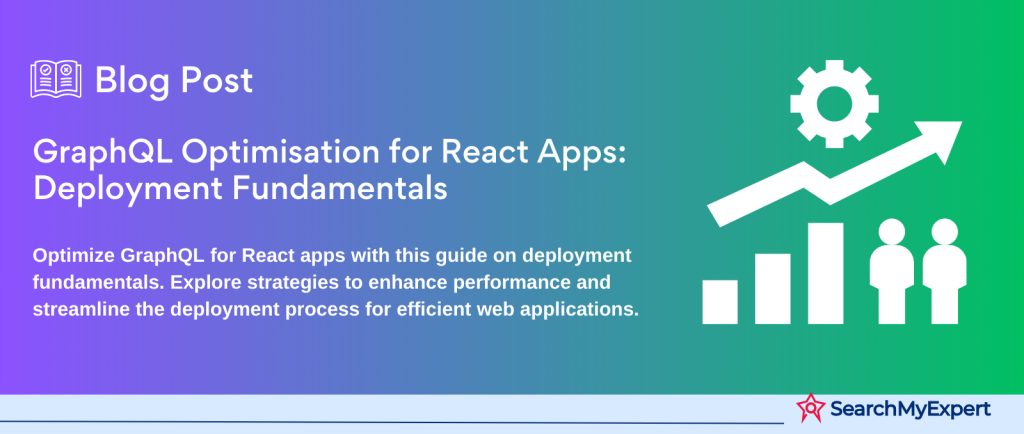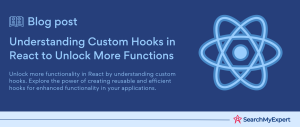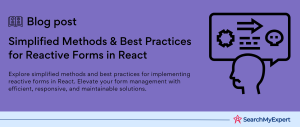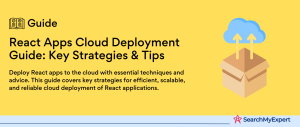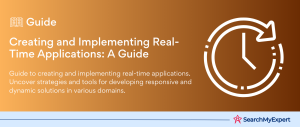Unlocking the Power of Data Fetching: Embracing GraphQL with React
In the fast-paced world of web development, the quest for more efficient, flexible, and scalable data-fetching solutions has led to the adoption of innovative technologies that streamline the way applications interact with data. Among these advancements, GraphQL stands out as a revolutionary query language for APIs, offering a robust alternative to the traditional REST architecture. When paired with React, a popular JavaScript library for building user interfaces, GraphQL empowers developers with unparalleled control over data retrieval, optimizing both the development process and the end-user experience. This comprehensive guide explores the essence of GraphQL, its benefits when used in conjunction with React, and scenarios where integrating GraphQL into your React projects is most advantageous.
What is GraphQL?
GraphQL is a query language for your API and a server-side runtime for executing queries by using a type system you define for your data. Unlike REST, which relies on a fixed structure of endpoints to request and receive data, GraphQL allows clients to request exactly the data they need, nothing more, nothing less. This capability not only reduces the bandwidth requirements but also alleviates the over-fetching and under-fetching issues commonly encountered in traditional REST APIs. With GraphQL, you define a schema that describes the shape of your data graph, making data querying more intuitive and efficient.
Benefits of Using GraphQL with React
Integrating GraphQL with React brings numerous advantages that enhance both developer productivity and application performance:
- Precise Data Fetching:
GraphQL’s query language enables React components to specify exactly what data they need. This precision eliminates unnecessary network requests and data fetching, leading to faster application performance and improved user experience. - Real-time Data with Subscriptions: GraphQL subscriptions offer a seamless way to fetch real-time data, making it easier to build interactive applications with React, such as live chat rooms or real-time notifications.
- Simplified Data Management: By handling data management logic on the server side, GraphQL reduces the complexity of managing state in React applications. This simplification allows developers to focus more on building features rather than managing data fetching logic.
- Strong Typing and Validation:
GraphQL’s schema provides a contract between the server and client, ensuring that data conforms to specific types. This strong typing facilitates early error detection and validation, enhancing code reliability and maintainability. - Developer Tooling and Ecosystem: The GraphQL ecosystem includes powerful developer tools, such as GraphiQL, an in-browser IDE, and Apollo Client, a comprehensive state management library for JavaScript that integrates seamlessly with React. These tools accelerate development and debugging, improving developer efficiency.
When to Consider Using GraphQL with React
While GraphQL offers significant benefits, it’s crucial to assess its suitability for your project. Consider integrating GraphQL with React when:
- You Require Fine-grained Data Control: If your application needs to fetch complex data from multiple sources or requires precise control over the data being retrieved, GraphQL’s query language can significantly optimize data fetching.
- Your Application Handles Real-time Data:
For applications that benefit from real-time data updates, such as social media platforms or collaboration tools, GraphQL subscriptions provide a robust solution for implementing real-time functionalities. - You Aim to Reduce Development Overhead: Projects that aim to minimize the time spent on writing and maintaining data-fetching code will find GraphQL’s single endpoint and typed schema to be a time-saving feature.
- Complex State Management Needs:
For applications with complex state management requirements, GraphQL’s declarative data fetching model simplifies state management, making it easier to maintain and scale your project.
Laying the Foundation: Setting Up GraphQL with React
To embark on a project that marries the capabilities of GraphQL with the reactive prowess of React, setting up the environment is a pivotal first step. This phase is all about ensuring that your toolkit is equipped with the necessary dependencies and configurations to facilitate seamless development. From selecting an apt GraphQL client to integrating a robust GraphQL server, this guide delineates the critical steps required to scaffold your development environment. Here’s how to lay down the groundwork for a dynamic, data-driven application harnessing the power of GraphQL and React.
Installing Necessary Dependencies
The journey begins with the installation of essential libraries that will empower your React application to communicate effectively with GraphQL. This involves setting up your project environment with the GraphQL language itself and choosing a client library that best aligns with your project’s needs.
Choosing a GraphQL Client for React
In the realm of React applications, the choice of a GraphQL client is crucial for defining how your application will interact with your GraphQL server. Two prominent contenders stand out:
- Apollo Client:
Renowned for its comprehensive feature set, Apollo Client is a popular choice among developers for its declarative approach to data fetching, extensive caching capabilities, and seamless integration with React. - Relay:
Developed by Facebook, Relay is tailored for high-performance applications with complex data requirements. It offers a strong type system and automatic data optimization, making it a fit for projects where efficiency and scalability are paramount.
Selecting between Apollo Client and Relay hinges on your project’s specific requirements, such as the complexity of the data operations, the need for real-time updates, and your team’s familiarity with the ecosystem around each client.
Setting Up a GraphQL Server
The next step involves choosing and configuring a GraphQL server. The server acts as the backbone of your application, processing requests and fetching data from your data sources. Here are a couple of options to consider:
- Apollo Server: As a counterpart to Apollo Client, Apollo Server offers an easy-to-set-up solution that integrates well with any GraphQL client. It’s known for its simplicity, extensive documentation, and compatibility with various data sources.
- Hasura: For projects requiring a rapid development cycle, Hasura automates the process of creating a GraphQL backend over a Postgres database, offering instant APIs without the need to write extensive backend logic. It’s ideal for projects that need to hit the ground running with minimal setup.
Choosing the right server setup depends on several factors, including your project’s data requirements, the need for custom resolvers, and the existing tech stack. Apollo Server provides a flexible, customizable environment suitable for a wide range of applications, whereas Hasura is a powerful tool for projects that can leverage its auto-generated APIs for a quick start.
Embracing the Power of GraphQL with React
With the necessary dependencies installed and the choice of GraphQL client and server made, you’re well on your way to developing a React application powered by the advanced data-fetching capabilities of GraphQL. This setup not only optimizes your development workflow but also paves the way for building more responsive, data-efficient applications. As you move forward, remember that the strength of GraphQL with React lies in their combined ability to fetch data precisely and efficiently, adapting to the evolving needs of modern web applications.
Sculpting the Data Landscape: Defining Your GraphQL Schema
At the heart of every GraphQL application lies its schema, a conceptual blueprint that defines how clients interact with data. The schema serves as a contract between the client and the server, outlining the types of data available and the operations that can be performed. This core component not only shapes the architecture of your GraphQL service but also enhances the developer experience by providing a clear and concise framework for data manipulation. In this section, we delve into the nuances of crafting a GraphQL schema for your React application, covering the essentials of data types, queries, mutations, and subscriptions.
Understanding the Role of the Schema
The GraphQL schema is pivotal in defining the structure of data and the operations allowed within your application. It specifies the types of objects that can be queried, the relationships between them, and how clients can interact with these objects. This explicit declaration ensures type safety and allows for introspection, enabling tools and libraries to automate much of the workload associated with data fetching and manipulation.
Defining Data Types and Queries
The foundation of a GraphQL schema is its data types. These types represent the various entities in your application and are defined using the GraphQL Type System. Here’s a breakdown of how to define your data types and queries:
- Scalar Types:
These are the basic data types such as String, Int, Float, Boolean, and ID. They represent the leaf nodes of your query structure. - Object Types:
These types define a collection of fields, where each field is associated with a specific scalar type or another object type, allowing you to model complex data structures. - Queries:
The query type is a special object type that serves as the entry point for data fetching operations. It allows clients to specify which data they wish to retrieve from the GraphQL server.
By defining your data types and queries, you establish the foundational queries that clients can execute against your GraphQL server. This process involves specifying the shape of your entities and the ways in which they can be accessed and manipulated through the GraphQL API.
Mutations and Subscriptions
Beyond queries, GraphQL schemas support two other types of operations: mutations and subscriptions. These operations enable clients to modify data and subscribe to real-time updates, respectively.
- Mutations:
Mutations allow clients to perform write operations (create, update, delete) on your data. Like queries, mutations are defined as part of the schema and specify the input parameters and return types for these operations. - Subscriptions:
Subscriptions provide a mechanism for real-time data fetching. By defining subscriptions in your schema, you can enable clients to listen for specific events and receive updates as they occur.
Empowering Your React Application with a Robust GraphQL Schema
Crafting a comprehensive GraphQL schema is a critical step in developing a React application that efficiently manages and manipulates data. By thoroughly defining your data types, queries, mutations, and subscriptions, you create a flexible and powerful API that caters to the specific needs of your application. This schema not only facilitates efficient data fetching and manipulation but also ensures that your application can evolve over time without compromising on performance or scalability.
As you embark on this journey, remember that the strength of your GraphQL implementation lies in the clarity, completeness, and flexibility of your schema, setting the stage for a seamless development experience and a robust, user-centric application.
Bridging Components and Queries: Connecting React to GraphQL
Integrating GraphQL into a React application marks a pivotal moment where the front end starts to seamlessly communicate with the back end, fetching, manipulating, and displaying data with unparalleled efficiency. This connection between React components and GraphQL queries is facilitated by a GraphQL client, which acts as the intermediary, managing the complexities of data fetching, state management, and error handling. In this step, we’ll explore how to make GraphQL queries from React components, utilize the chosen client for data management, and handle the different states like loading and errors, ensuring a robust and user-friendly application.
Making GraphQL Queries from React Components
The process of fetching data in a React application begins with defining GraphQL queries. These queries are then executed within React components, typically using hooks provided by the GraphQL client library. Here’s how to approach this:
- Define the GraphQL Query:
Start by writing the query that fetches the data you need. This query is defined using the GraphQL query language and usually encapsulates the data requirements of a specific component. - Use GraphQL Client Hooks:
With the query defined, the next step is to execute it within your React component. If you’re using Apollo Client, for example, you might use the useQuery hook. This hook takes your GraphQL query as an input and returns an object with properties such as loading, error, and data, which you can then use within your component to render the UI accordingly.
Using the Chosen Client to Fetch and Manage Data
A GraphQL client like Apollo Client or Relay significantly simplifies the process of fetching and managing data in a React application. These clients provide a set of tools and hooks that abstract away the complexities of data fetching, caching, and state management. Here’s what this typically involves:
- Fetching Data:
By using hooks like useQuery, you can easily fetch data from your GraphQL server. The hook automatically executes the query when the component mounts and provides the response data in a format that’s easy to integrate into your component’s output. - State Management:
The client also handles the state of each query, including loading states and error handling. This means you can easily display a loading indicator while the query is in progress or show error messages if something goes wrong. - Caching:
GraphQL clients often come with sophisticated caching mechanisms, which ensure that data previously fetched is reused efficiently, reducing the need for unnecessary network requests and speeding up your application.
Handling Errors and Loading States
Properly handling loading states and errors is crucial for a good user experience. Here’s how to manage these states effectively:
- Loading State: While a query is in progress, the loading property provided by your GraphQL client’s hook will be true. You can use this to display a loading indicator or a placeholder to inform the user that data is being fetched.
- Error Handling: If the query encounters an error, the error property will be populated with the details of what went wrong. This provides an opportunity to render error messages or fallback content, enhancing the resilience of your application.
- Optimistic UI Updates:
Some GraphQL clients offer the ability to perform optimistic UI updates for mutations, where the UI is updated before the server response is received, based on the expected outcome of the mutation. This can make your application feel faster and more responsive.
Elevating Your React Application with GraphQL Integration
By effectively connecting your React components to GraphQL, you not only streamline the process of data fetching but also enhance the overall architecture of your application. This integration facilitates a declarative approach to data fetching, where the focus shifts from the how to the what, allowing developers to concentrate on building user-centric features. With the power of GraphQL and a suitable client, your React application is well-equipped to handle complex data requirements with ease, adaptability, and performance.
Crafting Reactive UIs: Building Components with GraphQL Data
Integrating GraphQL with React ushers in a streamlined approach to building dynamic user interfaces that react in real time to data changes. By fetching data through GraphQL queries, React components can render content dynamically, adjust based on data availability, and respond to user interactions with updates. This symbiosis between GraphQL and React not only optimizes data fetching efficiency but also enhances user experience through responsive and interactive UIs. In this section, we delve into the nuances of rendering data with GraphQL, implementing conditional rendering, and handling user interactions within React components.
Rendering Data Fetched from GraphQL Queries
Once your GraphQL client has fetched data, the next step is to render this data within your React components. This involves mapping the fetched data to UI elements, ensuring that your application displays the information in a user-friendly manner. Here’s a guide to doing just that:
- Accessing Fetched Data:
Utilize the data returned from your GraphQL query, typically accessed via the data property when using hooks like useQuery. This data is usually an object that mirrors the structure of your GraphQL query. - Mapping Data to UI Components: Iterate over the fetched data, creating UI elements for each piece of data. For example, if you’re fetching a list of items, you might map each item to a <ListItem> component that displays the item’s details.
- Key Propagation: When rendering lists of elements in React, ensure that each element has a unique key prop. This helps React identify which items have changed, are added, or are removed, optimizing rendering performance.
Conditional Rendering Based on Data Availability
Handling the various states of your data fetch operation—loading, success, and error—requires conditional rendering. This technique ensures that your UI responds appropriately to the data’s state, enhancing the user experience:
- Loading State:
Display a loading indicator or placeholder content while the data is being fetched. This can be achieved by checking the loading state returned by your GraphQL client’s hook. - Error State: In case of an error during the data fetch, render an error message or a UI that gracefully informs the user of the issue. The error state from your GraphQL client can be used to determine this.
- Empty State: If the query succeeds but returns no data, consider displaying a message or a different UI element that informs the user that there is no data to show.
Handling User Interactions and Updates
Interactive applications often require not just displaying data but also allowing users to modify or update that data. Here’s how to handle such interactions in a GraphQL-powered React application:
- Mutations for Data Updates: Utilize GraphQL mutations to send updates to the server, such as adding, updating, or deleting data. React hooks like useMutation from Apollo Client can be used to trigger these mutations based on user actions, such as form submissions or button clicks.
- Optimistic UI Updates:
For a smoother user experience, implement optimistic updates that assume the mutation will succeed and immediately reflect the changes in the UI. If the mutation fails, you can then revert the UI to its original state. - Subscriptions for Real-time Data:
Implement GraphQL subscriptions to receive real-time updates from the server. This is particularly useful in applications requiring live data, such as chat applications or live feeds. Subscriptions ensure that your UI stays up-to-date with the latest data without requiring manual refreshes.
Elevating Component Interactivity with GraphQL
Building components that seamlessly integrate with GraphQL data transforms the way users interact with your application, offering them a dynamic and responsive experience. By rendering data efficiently, implementing conditional rendering based on data states, and handling user interactions with updates, your React application not only becomes more interactive but also more intuitive. As developers, leveraging GraphQL in React components empowers you to focus on creating engaging user experiences, backed by the robust and flexible data-fetching capabilities of GraphQL.
Elevating Efficiency: Advanced Techniques in GraphQL and React
In the journey of integrating GraphQL with React, mastering advanced techniques is crucial for enhancing application performance, achieving efficient data management, and ensuring real-time responsiveness. This exploration into optimizing queries, implementing caching strategies, and leveraging fragments and subscriptions opens up new avenues for building dynamic, efficient, and scalable applications. Here’s how you can incorporate these advanced practices into your React application to harness the full potential of GraphQL.
Optimizing Queries for Performance
The efficiency of GraphQL queries directly impacts your application’s performance. Optimizing these queries ensures that your application consumes less bandwidth and the server spends fewer resources processing requests.
- Selective Data Fetching:
Utilize GraphQL’s strength in fetching exactly what is needed and nothing more. Tailor your queries to request only the fields required by the component, reducing the amount of data transmitted over the network. - Query Batching: Implement query batching to combine multiple queries into a single request. This reduces the number of server round-trips, decreasing latency and improving load times.
- Persisted Queries:
Use persisted queries to streamline communication between the client and server. By pre-registering queries on the server, clients can reference them with a unique identifier, reducing the size of the request payload.
Implementing Caching Strategies
Caching is a powerful mechanism for enhancing the performance of your GraphQL-powered React application, minimizing unnecessary network requests, and providing faster access to previously fetched data.
- Client-Side Caching:
Leverage the caching capabilities of your GraphQL client (e.g., Apollo Client) to cache query results on the client side. This allows your application to instantly retrieve data from the cache for repeated queries, rather than making additional network requests. - Optimistic UI Updates:
Enhance the user experience with optimistic UI updates. By predicting the outcome of mutations and updating the UI in advance, you can make your application feel more responsive and fluid. - Cache Normalization:
Ensure your caching strategy employs cache normalization, which stores data in a normalized, flat structure in the cache. This approach avoids data duplication and ensures consistency across your UI, automatically updating all instances of a data object when it changes.
Using Fragments and Subscriptions for Dynamic Data
To further refine your application’s data handling and update mechanisms, incorporating fragments and subscriptions offers a path to more dynamic and real-time data management.
- Fragments: Utilize GraphQL fragments to define reusable sets of fields on specific types. Fragments help in maintaining consistency in data requirements across components, making your queries more maintainable and your application more predictable.
- Subscriptions:
Implement GraphQL subscriptions to handle real-time data. Subscriptions allow your application to maintain a live connection to the server, receiving updates as soon as they happen. This is particularly useful for applications requiring instant data updates, such as messaging apps or live feed systems.
From Development to Deployment: Mastering React and GraphQL Integration
The journey of developing a React application integrated with GraphQL culminates in its deployment, but this final stage demands careful consideration of security, testing, and maintenance to ensure the application’s success and longevity. This guide outlines the essential steps for deploying your React and GraphQL application, alongside best practices for security, testing, and ongoing maintenance, ensuring your project not only thrives in the live environment but also remains robust, secure, and scalable over time.
Deploying Your React App with GraphQL Integration
Deployment marks the transition of your application from development to production, making it accessible to end-users. Here’s how to approach this crucial phase:
- Choose a Hosting Service: Select a hosting provider that aligns with your project’s needs, considering factors like scalability, cost, and support for both static sites (for your React frontend) and dynamic services (for your GraphQL server).
- Optimize for Production: Before deployment, ensure your application is optimized for performance. This includes minifying JavaScript and CSS files, optimizing images, and implementing code splitting in React to reduce the initial load time.
- Environment Configuration: Configure environment variables for your production environment, including API endpoints, database connections, and any third-party service credentials, ensuring they are securely managed and not exposed in your codebase.
- Continuous Integration and Deployment (CI/CD): Automate your deployment process with CI/CD pipelines. This approach enables automatic testing and deployment of your code to production whenever changes are made, ensuring a consistent and error-free deployment process.
Security Considerations for GraphQL APIs
Security is paramount, especially for applications dealing with sensitive data. Here are key considerations to secure your GraphQL API:
- Validation and Rate Limiting: Implement query validation to prevent malicious or poorly formed queries from affecting your server. Rate limiting is also crucial to protect against denial-of-service (DoS) attacks.
- Authentication and Authorization:
Secure your GraphQL endpoints with robust authentication and authorization mechanisms. Ensure that users can only access data they are permitted to see, leveraging JSON Web Tokens (JWT) or similar strategies for securing API requests. - HTTPS:
Always use HTTPS to encrypt data in transit, protecting sensitive information from being intercepted.
Testing and Maintaining Your GraphQL Integration
Ensuring the reliability and performance of your GraphQL integration requires comprehensive testing and diligent maintenance:
- Write Unit and Integration Tests:
Cover your backend with tests that ensure each resolver functions as expected, and that integrations between your server and database handle data correctly. - Test Your Frontend: Implement end-to-end tests for your React application, simulating real user interactions and validating that the UI behaves correctly with dynamic data fetched from your GraphQL API.
- Monitor Performance: Use monitoring tools to track the performance of your GraphQL queries and mutations, identifying any bottlenecks or inefficiencies.
- Stay Up-to-Date: Regularly update your dependencies, including React, GraphQL libraries, and any third-party services, to benefit from the latest features and security patches.
Conclusion:
The integration of GraphQL with React represents a significant leap forward in building dynamic, efficient, and scalable web applications. Throughout this comprehensive guide, we’ve explored the foundational steps from setting up your environment and defining your GraphQL schema to connecting React components with GraphQL data. We delved into advanced techniques for optimizing performance, implementing caching strategies, and using fragments and subscriptions for dynamic data handling. Finally, we navigated the critical stages of deploying your application, emphasizing security considerations, testing strategies, and best practices for maintaining your GraphQL integration.
As we conclude, it’s evident that the journey from development to deployment encompasses much more than merely writing code. It involves strategic planning, a deep understanding of both GraphQL and React, and a commitment to security, testing, and continuous improvement. By adhering to the guidelines and best practices outlined in this guide, developers can not only deploy their applications with confidence but also ensure their projects remain adaptable, secure, and performant in the ever-evolving landscape of web development.
Guide your project to success with our React Development Service Company.
Table of Contents
Toggle
